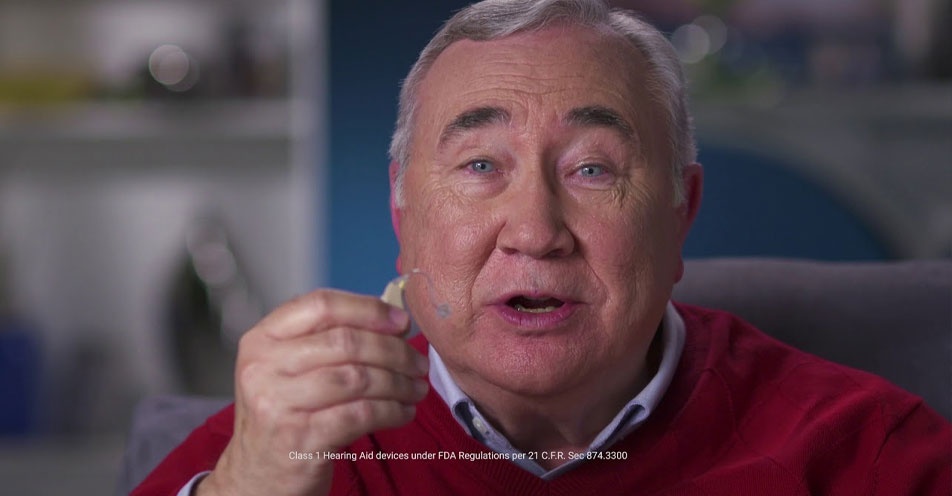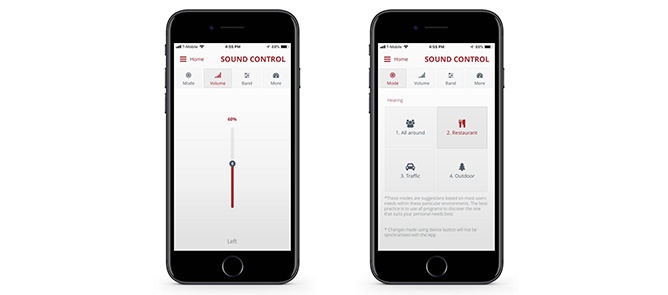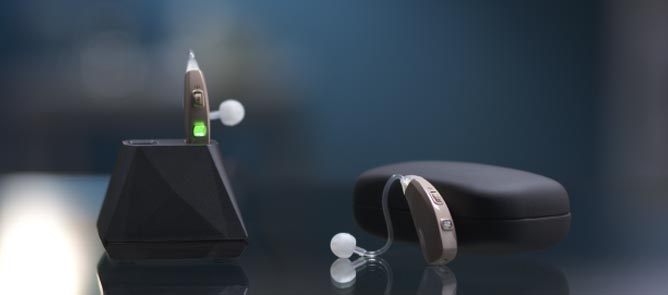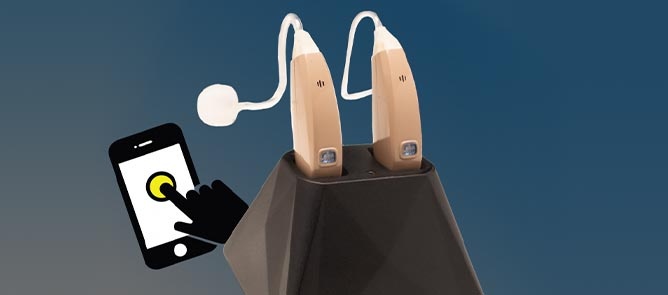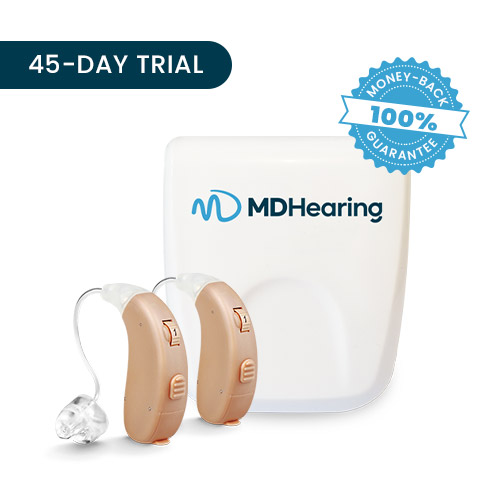Hearing Assist is an over-the-counter hearing aid manufacturer that sells hearing aids for a dramatically lower price than traditional manufacturers. By selling their hearing aids direct-to-consumer—instead of through a hearing clinic—Hearing Assist keeps costs low and offers patients the convenience of treating their hearing loss conditions without leaving the comfort of their homes.
Since launching in 2008, Hearing Assist has tried to provide an affordable way for patients to improve their hearing—and the quality of their lives—while saving thousands of dollars in the process. Considering that Hearing Assist hearing aids cost between $399 and $599 a pair, the brand is definitely opening the door for more patients to afford hearing loss treatment. This costs much lower than the average of $4,600 per pair when buying name brands like Oticon or Phonak through a hearing clinic, or $1,850 - $2,950 from other direct sellers like Eargo.
The question is:
Does Hearing Assist treat hearing loss effectively, or are you sacrificing too much performance with this low-cost brand?
In this guide, we’ll answer this question by taking a close look at Hearing Assist technology and styles, the durability and quality of the product, and some customer reviews to provide a complete overview of this hearing aid manufacturer.
We’ll also see how Hearing Assist compares to MDHearing, its biggest competitor in the direct-to-consumer/over-the-counter hearing aid space.
Please use the following links to navigate this guide:
- Hearing Assist Design and Technology Features
- Hearing Assist Models and Pricing
- Quality and Reliability of Hearing Assist (Real User Reviews)
- An Affordable Alternative to Hearing Assist: MDHearing
- Final Thoughts on Hearing Assist and MDHearing
Hearing Assist Design and Technology Features
The design and technology strategy that Hearing Assist applies to its products focuses on affordability and effectiveness. They sell one in-the-ear (ITE) style and two behind-the-ear (BTE) styles.
The form-follows-function design strategy of this hearing aid brand offers a no-frills “look” for maximum cost-efficiency. Four design features stand out:
- Beige in color: Hearing Assist hearing aids are beige, except for the mid-range model (ReCharge Behind The Ear Hearing Aid), which has a gray option.
- Functional design: Hearing Assist hearing aids feature an overall design style that’s functional in nature. These hearing aids aren’t supposed to win any style competitions, but they may help you understand your friends when they compliment you on your outfit!
- Push-buttons, dial, or app-based operation: All of the Hearing Assist designs use a push-button to turn them on and off. The two entry-level models use either a push-button or dial for volume control. The highest-tech Hearing Assist model (ReCharge Behind The Ear Bluetooth Hearing Aid) features app-based volume adjustments and sound environment adjustments; you can’t operate this hearing aid without the app.
Hearing Assist Listening Environment Sound Profiles
Hearing Assist’s in-the-ear (ITE) model (ReCharge In The Ear Hearing Aid) is the only one without listening environment programs to select from. The two behind-the-ear (BTE) styles feature four listening programs that users can cycle through depending on external sound conditions:
- Program 1 “Quiet Environments”: This setting is for quiet areas with little-to-no background noise. This setting tries to achieve high-fidelity sound quality for the home and office.
- Program 2 “Noisy Environments”: This setting is for noisy listening conditions like restaurants, parties, or gatherings with multiple people speaking at the same time. It activates the hearing aid’s noise reduction features.
- Program 3 “TV Mode”: This setting is for listening to the television. It reduces the high and low sound frequencies for optimum TV sound listening.
- Program 4 “Outdoors”: This setting is for outdoor conditions when wind noise interferes with hearing aid operation. It tries to reduce wind noise distractions.
Hearing Assist Smartphone App
The highest-tech offering from Hearing Assist (ReCharge Behind The Ear Bluetooth Hearing Aid) comes with a smartphone app that connects to the hearing aids via Bluetooth. The app lets users adjust the hearing aid on-the-fly while they are wearing them. You can adjust volume, and cycle through four program settings for different hearing environments. The app’s “Hearing Check” feature will perform a hearing check and automatically change the volume settings, sound frequencies, and background noise settings based on your test results.
Compared to other hearing aid smartphone apps, this app is lacking a few common features:
- The Hearing Assist app cannot manually change microphone directionality or noise reduction. It is limited to the automatic adjustments it makes based on the results of the “Hearing Check” feature.
- Hearing Assist support staff cannot remotely change the settings on your hearing aids via the smartphone app.
- Users cannot make volume and sound environment changes via the hearing aid itself. They can only make these adjustments within the app.
- Users cannot use the hearing aid without a compatible smartphone.
Hearing Assist Rechargeable Batteries
All Hearing Assist hearing aid models use rechargeable batteries and include a charging station. According to the Hearing Assist website, it takes around 3 hours to charge the batteries for approximately 18 to 20 hours of use.
Rechargeable batteries offer the convenience of not needing to constantly replace your hearing aid batteries—and they eliminate the expense of purchasing new batteries. However, some users might prefer replaceable batteries because the hearing aids are more portable, you can easily switch out batteries on the go, and you don’t have to wait hours for the hearing aids to charge.
At MDHearing, our product lineup includes both rechargeable and replaceable battery hearing aid options so our customers can choose the style that suits them best.
Hearing Assist Models and Pricing
Hearing Assist sells three hearing aid models on its website. All three models are FDA-registered hearing aids, so they qualify as “medical devices” for treating hearing loss. As direct-to-consumer-hearing aids, users can order Hearing Assist products by phone or internet without visiting an audiologist or hearing clinic.
Here’s a review of each model:
Hearing Assist ReCharge In The Ear Hearing Aid
The “Hearing Assist ReCharge In The Ear Hearing Aid” is an ITE hearing aid, so the entire device sits in the ear. As a medium-sized ITE model, it is still quite noticeable and far from “invisible.” Users who want an “invisible” hearing aid that inserts fully in the ear canal should choose a different manufacturer. This hearing aid is suitable for mild to moderately-severe hearing loss.
Here’s what you get when you purchase this model:
- A dehumidifying charging case
- Two HABIO-KLR-S in-the-ear rechargeable hearing aids
- The battery takes about 3 hours to charge for approximately 18 to 20 hours of operation
- As much as 35dB amplification
- Digital sound technology
- Layered background noise reduction features
- Feedback suppression features
- 60-day satisfaction guarantee and 1-year warranty
This ITE hearing aid is the lowest-tech offering from Hearing Assist, so users are sacrificing a lot of helpful tech features just to get an ITE design. It does not include multiple sound environment programs, and users only have four volume level settings to choose from. You change the volume setting by pressing a small button on the side of the hearing aid.
If you’re dead-set on buying a Hearing Assist product, you might want to consider other models from this brand. For example, the “ReCharge Behind the Ear” model (below) offers considerably better hearing aid technology and performance for the exact same price.
The Hearing Assist ReCharge In The Ear Hearing Aid was priced at $699.99 per pair but is no longer available on HearingAssist's website.
In terms of tech levels, the MDHearing AIR, is the closest alternative to this hearing aid in the MDHearing lineup. As a behind-the-ear style hearing aid, the AIR is a different style, but it does include four sound environment programs for different listening situations, feedback suppression technology, background noise reduction, and digital sound technology. The MDHearing AIR is also less expensive, costing only $299.92 per pair!
Hearing Assist ReCharge Behind The Ear Hearing Aid
The “Hearing Assist ReCharge Behind The Ear Hearing Aid” is a BTE style, so all of the hearing aid components rest behind your ear. As Hearing Assist’s mid-level offering, it offers slightly better tech and performance than the ITE model reviewed above. This hearing aid is suitable for mild to moderately-severe hearing loss.
The “ReCharge Behind The Ear” doesn’t include smartphone app connectivity, so all settings adjustments are achieved via the hearing aid itself. This model features a single button for turning the device on and off and for cycling through the four sound environment programs: quiet, noisy, TV, and outdoor (see descriptions above). The hearing aid also includes a dial to adjust the volume as desired.
Here’s what you get when you purchase this model:
- Two rechargeable BTE hearing aids
- The battery takes about 3 to 3.5 hours to charge for approximately 20 hours of operation
- 4 sound environment programs
- Directional microphone features for better hearing in noisy conditions
- Digital sound technology
- As much as 43dB amplification
- Layered background noise reduction features
- Feedback suppression technology
- Charging station
- 60-day satisfaction guarantee and 1-year warranty
The Hearing Assist ReCharge Behind The Ear Hearing Aid is priced at $499.98 per pair.
This hearing aid is similar to the MDHearing VOLT, which is rechargeable, includes directional microphones, offers advanced background noise reduction, feedback reduction, and features four sound environment programs for different listening situations. The MDHearing VOLT is priced at $299.98 per pair.
Hearing Assist ReCharge Behind The Ear Bluetooth Hearing Aids
The Hearing Assist ReCharge Behind The Ear Bluetooth Hearing Aid includes the most advanced tech features of the Hearing Assist lineup. As for hearing aid technology and hardware, it’s the same as the “ReCharge Behind The Ear Hearing Aid” reviewed above, except for one difference: It connects to a smartphone app via Bluetooth.
As we mentioned above, the smartphone app allows users to control the hearing aid, and it includes a “Hearing Check” feature that tests your hearing and automatically optimizes the hearing aid based on the results.
Beyond this automatic adjustment feature, there’s no way for users to fine-tune this hearing aid to their unique hearing loss profile. Furthermore, support staff at Hearing Assist cannot remotely adjust the hearing aid to reflect a medically-tested hearing loss profile. This is a big area of difference from other hearing aids, like the MDHearing VOLT MAX, which allows for more precise customization by a certified audiologist.
This hearing aid is suitable for mild to moderately-severe hearing loss.
Here’s what you get with this hearing aid:
- An app-based Hearing Check feature that automatically optimizes the hearing aid
- Control of the hearing aid via the Bluetooth-connected smartphone app
- Two rechargeable BTE hearing aids
- The battery takes approximately 3.5 hours to charge for about 18 hours of operation
- Digital hearing aid technology
- As much as 43dB amplification
- Layered background noise reduction
- Feedback suppression technology
The Hearing Assist ReCharge Behind The Ear Bluetooth Hearing Aid is priced at $599.99 per pair.
This hearing aid is most similar to the MDHearing VOLT MAX. Keep reading for a more detailed comparison of these two hearing aids below.
Quality and Reliability of Hearing Assist (Real User Reviews)
Although we like the fact that Hearing Assist is opening the door to more affordable hearing treatment, after pouring over the online reviews, we have serious reservations about the quality, craftsmanship, and durability of this product. Hearing Assist has an average 2.3-star out of 5-star rating on Highya.com.
Here’s what real customers are saying about the Hearing Assist experience:
Problems with Product Quality and Could Not Return the Defective Item:
I ordered a Hearing Assist Aide which ended up being $720.00. Be aware they have "No Warranty" other than the 60-day money-back guarantee unless you pay additional fees. I began to have problems with the attachment tubes coming loose which caused one of the hearing aids to fall from my ear and in the toilet. The tubes start turning loose after about two weeks. I contacted Hearing Assist to receive additional tubes and that was when I found out I was going to have to pay for them. This is a Defect in their product which can cause a consumer $300.00 plus dollars especially if the Hearing Aid goes bad or becomes damaged because the Tubes won't stay attached to the unit. Buyers beware and get all the facts upfront and Record the call for your own protection." – Jeffery G. Douglas, Aug. 15, 2019
Manufacturer Refused to Refund Broken Product (1 Out of 5-Star Rating):
Hearing aid wouldn’t hold a charge for the left earpiece. Returned after customer service said that since I bought a protection plan they would take care of it. A week or so later it was shipped back with a note that read that because the credit card that I bought the aids and protection plan with had since expired. What the card expiration after the purchase has to do with them honoring their protection plan is not relevant. It was valid at the time of purchase of the product and protection plan and they got paid in full. They don’t keep their promises or honor their plan. Don’t trust them. Bottom Line: No, I would not recommend this to a friend." – Charlie L., Michigan, Apr 2, 2020
Product Fell Apart After One Month of Use (1 Out of 5-Star Rating):
Cheap, cheap, cheap. Within a month of purchasing the Hearing Assist, the plastic ear inserts separated from the hearing device. The metal was screwed to the plastic. After reattaching the two pieces a few times, it became more and more difficult to reattach. This device is a waste of money. If it is too good to be true, it probably is not true. Don't waste your money. Bottom Line: No, I would not recommend this to a friend." – Recer T., Florida, Nov 7, 2019
Very Happy With Product Quality and Performance (5 Out of 5-Star Rating)
Very happy to have purchased it. My husband was told by Miracle ear to purchase $7000.00 hearing aids. We didn't do it! Knew someone who bought these, was a farmer too. He loved them! My husband is happy and can hear so much better! Glad we tried them! Only had two weeks so far." – Sharon, February 15, 2020
Read more Hearing Assist reviews from real customers here and read Better Business Bureau complaints here.
An Affordable Hearing Assist Alternative: MDHearing
MDHearing is an alternative hearing aid option that you can also buy over-the-counter and direct-to-consumer. We’re also the primary affordable hearing aid competitor of Hearing Assist, so you might want to see how MDHearing compares.
Similarities of Hearing Assist and MDHearing:
Here’s what MDHearing and Hearing Assist have in common:
- FDA-Registered: Both are medical-grade hearing aids registered with the FDA to effectively treat hearing loss.
- No Office Visits Required: Both hearing aids allow you to purchase hearing aids without visiting a specialist and without leaving your home.
- Smartphone App Compatible: Both manufacturers sell a hearing aid model with smartphone app compatibility.
- Customization features: Both brands sell a hearing aid with the ability to customize its settings to reflect your unique hearing loss condition. In the case of MDHearing, the VOLT MAX model offers more detailed customization by an audiologist to fit your specific hearing loss spectrum.
- Affordable: Both brands are similarly priced and cost thousands of dollars less than the leading hearing aid brands sold at audiology offices and hearing clinics.
Differences Between MDHearing vs. Hearing Assist
Here’s how MDHearing and Hearing Assist are different from each other:
Fine-Tuning and Customization Comparison:
The Bluetooth-compatible model of Hearing Assist hearing aids offers some basic optimization features beyond the four sound environment programs, which is an added bonus to this affordable hearing aid brand. However, compared to the customization features of the MDHearing VOLT MAX, Hearing Assist’s customization options are primitive.
With Hearing Assist, users are limited to the app’s automated optimization features based on the results of the in-app “Hearing Check” test. The MDHearing VOLT MAX smartphone app also includes an in-app hearing test, and it will automatically optimize the hearing aid to your unique hearing loss profile. But on top of that, the VOLT MAX allows users to customize their hearing aid settings even more.
MDHearing users can get a professional hearing test from an audiologist or hearing clinic, and send the results to one of MDHearing’s certified audiologists. By contacting MDHearing support, our hearing healthcare professionals will use your professional audiogram to program the VOLT MAX based on NAL2 prescriptive fitting formulas. We do this remotely, so you never have to leave the house!
Compared to Hearing Assist, the MDHearing VOLT MAX offers more advanced and precise customization features—in addition to customization done by hearing healthcare professionals according to medically-accepted hearing loss treatment standards.
Smartphone App Independence Comparison:
Both Hearing Assist and MDHearing offer smartphone app capabilities in their highest-end hearing aid models. However, Hearing Assist’s smartphone model is tied to the app. Users can’t make volume adjustments or change the sound environment program without using the Hearing Assist smartphone app.
MDHearing’s smartphone-compatible hearing aid, the VOLT MAX, is app independent. Users don’t have to use a smartphone to benefit from the high-tech features of this hearing aid. Once the hearing aid is set up and customized for your unique hearing loss profile, you never have to look at the app if you don’t want to. You can change the volume and cycle through four different sound environment programs via the buttons on the hearing aid.
Price Comparison:
The price range for both of these hearing aid brands is similar. Priced as low as $299 per pair, MDHearing’s entry-level models are more affordable than Hearing Assist’s entry-level models. The smartphone app compatible MDHearing VOLT MAX is priced at $699 per pair, which is $200 less expensive than Hearing Assist’s smartphone app compatible model which costs $899.99.
For a lower price, the MDHearing VOLT MAX gives you more specific hearing loss treatment for your unique hearing loss situation.
Final Thoughts on Hearing Assist and MDHearing
In our opinion, Hearing Assist has certainly lowered the cost of hearing loss treatment by making hearing aids less expensive. However, after looking at customer reviews, we are concerned about the quality and durability of Hearing Assist hearing aids. For many customers, Hearing Assist products break after the warranty expires, and they cannot return them.
If you’re considering purchasing a Hearing Assist product, we encourage you to take a look at MDHearing. For a similar price-tag, MDHearing offers more advanced technology, better customization features, and better quality and durability.
The bottom line: Compared to Hearing Assist, MDHearing offers superior hearing aid technology, higher quality craftsmanship, and more prescriptive and precise hearing loss treatment.
Try MDHearing Risk-Free!
You don’t have to take our word for it. Try MDHearing for yourself, risk-free. If you don’t like your MDHearing hearing aids, you can return them with our 100% money-back satisfaction guarantee.
See what real people say about MDHearing.
BROWSE REVIEWS
